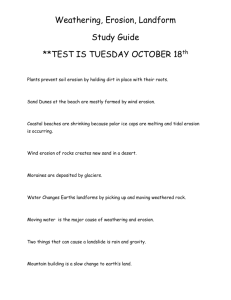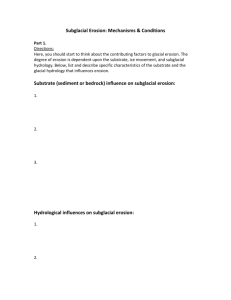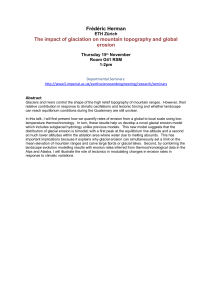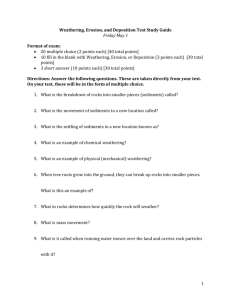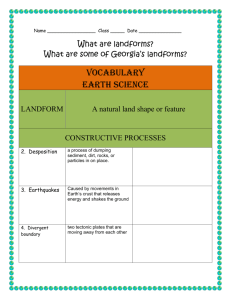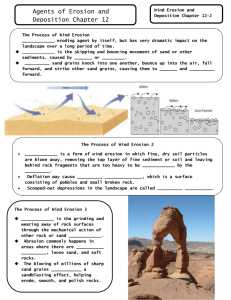Erosion and Climate Change: Land Erosion, Beach Erosion, Glacial
advertisement
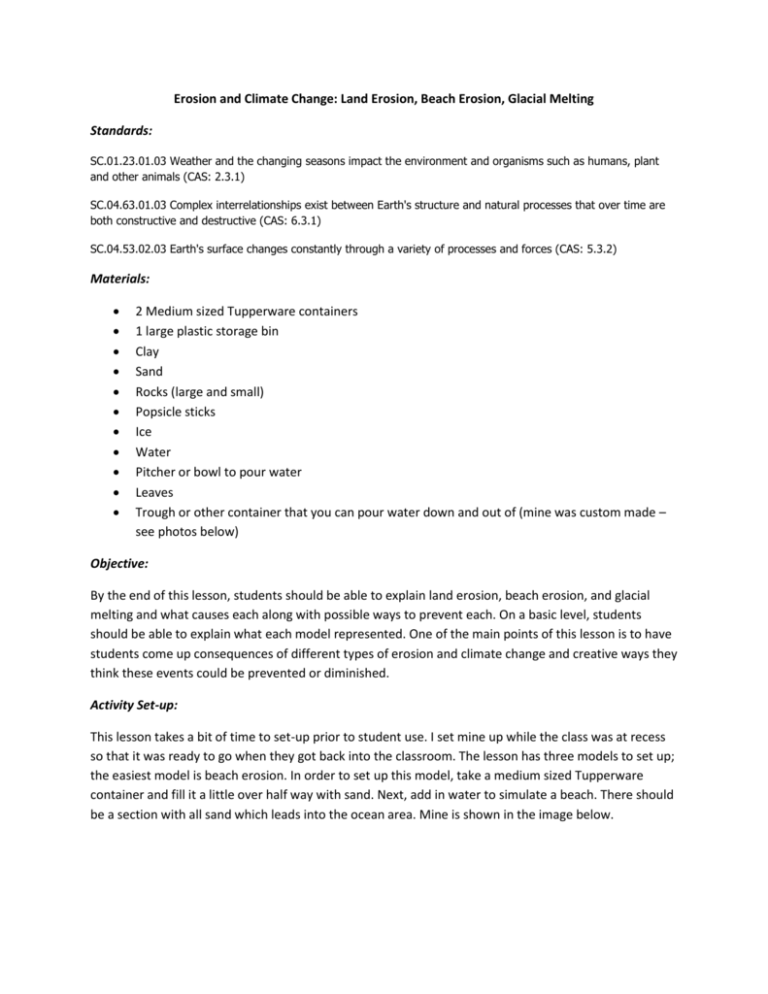
Erosion and Climate Change: Land Erosion, Beach Erosion, Glacial Melting Standards: SC.01.23.01.03 Weather and the changing seasons impact the environment and organisms such as humans, plant and other animals (CAS: 2.3.1) SC.04.63.01.03 Complex interrelationships exist between Earth's structure and natural processes that over time are both constructive and destructive (CAS: 6.3.1) SC.04.53.02.03 Earth's surface changes constantly through a variety of processes and forces (CAS: 5.3.2) Materials: 2 Medium sized Tupperware containers 1 large plastic storage bin Clay Sand Rocks (large and small) Popsicle sticks Ice Water Pitcher or bowl to pour water Leaves Trough or other container that you can pour water down and out of (mine was custom made – see photos below) Objective: By the end of this lesson, students should be able to explain land erosion, beach erosion, and glacial melting and what causes each along with possible ways to prevent each. On a basic level, students should be able to explain what each model represented. One of the main points of this lesson is to have students come up consequences of different types of erosion and climate change and creative ways they think these events could be prevented or diminished. Activity Set-up: This lesson takes a bit of time to set-up prior to student use. I set mine up while the class was at recess so that it was ready to go when they got back into the classroom. The lesson has three models to set up; the easiest model is beach erosion. In order to set up this model, take a medium sized Tupperware container and fill it a little over half way with sand. Next, add in water to simulate a beach. There should be a section with all sand which leads into the ocean area. Mine is shown in the image below. The next model to set-up is the glacial melting model. For this simulation, take the second medium sized Tupperware container and place a large rock in it; this rock represents an island or land mass. Next, build your glacier by stacking ice cubes next to your land mass (I had to put some smaller rocks in as well to hold the ice cubes in place. Finally, fill the container with water so that the water level is just below the top of your land mass. I made a small house and tree for my island; my model can be seen below. The final model is the most time consuming to set-up. To start, take your trough (or whatever item you are using in its place) and place one end on a smaller chair and the other end on the edge of your large plastic container. This should create a slight slope which will help the water to move “downhill” in the activity. Next, use your larger rocks to create hills, coves, and other geographic areas. Sprinkle sand and leaves around the trough to simulate loose dirt and debris. I included trees (made of clay and popsicle sticks to show that sand that was captured by the trees roots (stuck to the clay on the bottom) was less likely to be swept downhill. My model can be seen below. Activity: Begin by explaining to the students what each model represents and how these types of erosion and melting actually occur. Next, split the students into three groups and let each group play with the models. Rotate though until each group has had time to see all three. In the beach erosion group, demonstrate how if you make small waves with you hand, you can see sand being pulled down from the beach as the water goes back to the ocean. Let them try and ask them to think about how this actually works and what the consequences could be. In the glacial melting group, ask the students why they think they ice is melting and what is happening in the model. Have the students think about how actual glacial melting could affect us. In the land erosion group, have students try to arrange the terrain so that as little land is eroded as possible. Some examples of set-ups my students tried were using rocks to seclude the sand and trees, making channels for the water to run down that would avoid the sand and trees, and creating dams with the rocks. Ask the students which parts of the terrain are most likely to get washed away, which are the least likely, and why. Have students think about where land erosion might occur in areas near them and what the consequences are. I asked students to think about what happens at mining sites when all of the trees are cut down at the tops of mountains. When each group has seen all of the models, discuss their ideas of real-life examples of the models and what they think the consequences would be as a class. Ask students if they can think of ways to correct damage done by major land erosion and beach erosion, or if they can come up with ways to prevent massive glacial melting. Extensions: I have done this activity with 1st grade, 3rd grade, and 4th/5th grade classes and it has gone well in all cases. Since the activity does involve a lot of set-up, the extension provided gives a lesson using only the glacial melting activity. Note that although the extension describes the glacier activity, any of the three models could be similarly separated and taught as separate lessons. Use a large plastic container and large rocks to set up an island in the middle of the container. Let students create trees, animals, houses, etc. for the island. Take a large block of ice (or use ice cubes as described above) to create a large glacier next to the island. If a block of ice is used, it will take much longer for it to melt allowing students to more easily see the slow progression of the water level rise. Fill the container with water up to the point where the water level is just below the island level. Have students write their productions and track the progression of the water level. Discuss with students what will happen to their animals, plants, etc. as the water continues to rise. (Credit for this extension and the glacier melting idea goes to Anton Filatov)
